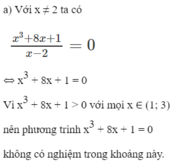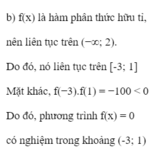Hãy nhập câu hỏi của bạn vào đây, nếu là tài khoản VIP, bạn sẽ được ưu tiên trả lời.

a: Đặt \(A\left(x\right)=x^5-5x^3+4x-1\)
Vì A(x) là đa thức bậc 5 nên A(x) có tối đa 5 nghiệm(*)
\(A\left(-2\right)=\left(-2\right)^5-5\cdot\left(-2\right)^3+4\cdot\left(-2\right)-1=-1\)
\(A\left(-1,5\right)=\left(-1,5\right)^5-5\cdot\left(-1,5\right)^3+4\cdot\left(-1,5\right)-1=\dfrac{73}{32}\)
\(A\left(1\right)=1^5-5\cdot1^3+4\cdot1-1=-1\)
Vì \(A\left(-2\right)\cdot A\left(-1,5\right)< 0\)
nên phương trình A(x)=0 có một nghiệm thuộc đoạn (-2;-1,5)(1)
Vì \(A\left(-1,5\right)\cdot A\left(1\right)< 0\)
nên phương trình A(x)=0 có một nghiệm thuộc đoạn (-1,5;1)(2)
\(A\left(0\right)=0^5-5\cdot0^3+4\cdot0-1=-1\)
\(A\left(\dfrac{1}{2}\right)=\left(\dfrac{1}{2}\right)^5-5\cdot\left(\dfrac{1}{2}\right)^3+4\cdot\dfrac{1}{2}-1=\dfrac{13}{32}\)
\(A\left(1\right)=1^5-5\cdot1^3+4\cdot1-1=-1\)
Vì \(A\left(0\right)\cdot A\left(\dfrac{1}{2}\right)< 0\)
nên phương trình A(x)=0 có một nghiệm thuộc đoạn (0;1/2)(3)
Vì A(1/2)*A(1)<0
nên phương trình A(x)=0 có một nghiệm thuộc đoạn (1/2;1)(4)
\(A\left(2\right)=2^5-5\cdot2^3+4\cdot2-1=-1\)
\(A\left(3\right)=3^5-5\cdot3^3+4\cdot3-1=119\)
Vì A(2)*A(3)<0
nên phương trình A(x)=0 có một nghiệm thuộc đoạn (2;3)(5)
Từ (1),(2),(3),(4),(5) suy ra A(x) có ít nhất 5 nghiệm
Kết hợp với cả (*), ta được: A(x) có đúng 5 nghiệm
b: Đặt \(B\left(x\right)=4x^3-8x^2+1\)
\(B\left(-0,5\right)=4\cdot\left(-0,5\right)^3-8\cdot\left(-0,5\right)^2+1=-1,5\)
\(B\left(0\right)=4\cdot0^3-8\cdot0^2+1=1\)
Vì \(B\left(-0,5\right)\cdot B\left(0\right)< 0\)
nên phương trình B(x)=0 có một nghiệm thuộc (-0,5;0)
=>Phương trình \(4x^3-8x^2+1=0\) có nghiệm thuộc (-1;2)

Đặt \(f\left(x\right)=8x^3-6x-1\)
Hàm số liên tục trên R
\(f\left(-1\right)=-3< 0\) ; \(f\left(-\dfrac{1}{2}\right)=1>0\)
\(\Rightarrow f\left(-1\right).f\left(-\dfrac{1}{2}\right)< 0\Rightarrow f\left(x\right)\) có 1 nghiệm thuộc \(\left(-1;-\dfrac{1}{2}\right)\)
\(f\left(0\right)=-1< 0\Rightarrow f\left(-\dfrac{1}{2}\right).f\left(0\right)< 0\Rightarrow f\left(x\right)\) có 1 nghiệm thuộc \(\left(-\dfrac{1}{2};0\right)\)
\(f\left(1\right)=1>0\Rightarrow f\left(0\right).f\left(1\right)< 0\Rightarrow f\left(x\right)\) có 1 nghiệm thuộc \(\left(0;1\right)\)
\(\Rightarrow f\left(x\right)=0\) có 3 nghiệm pb
Do cả 3 nghiệm của \(f\left(x\right)\) đều thuộc \(\left(-1;1\right)\) nên ta chỉ cần xét các giá trị x thuộc khoảng này
Đặt \(x=cosu\) pt trở thành:
\(8cos^3u-6cosu-1=0\Leftrightarrow2\left(4cos^3u-3cosu\right)=1\)
\(\Leftrightarrow cos3u=\dfrac{1}{2}\)
\(\Rightarrow\left[{}\begin{matrix}u=\dfrac{\pi}{9}+\dfrac{k2\pi}{3}\\u=-\dfrac{\pi}{9}+\dfrac{k2\pi}{3}\end{matrix}\right.\) \(\Rightarrow u=\left\{\dfrac{\pi}{9};\dfrac{5\pi}{9};\dfrac{7\pi}{9}\right\}\)
\(\Rightarrow x=\left\{cos\dfrac{\pi}{9};cos\dfrac{5\pi}{9};cos\dfrac{7\pi}{9}\right\}\)

a: Đặt f(x)=x3+x-1
\(f\left(0\right)=0^3+0-1=-1\)
\(f\left(1\right)=1^3+1-1=1\)
Vì \(f\left(0\right)\cdot f\left(1\right)=-1< 0\)
nên f(x)=0 có ít nhất một nghiệm thuộc đoạn (-1;0)
=>Phương trình \(x^3+x-1=0\) có nghiệm
b: Đặt \(A\left(x\right)=4x^4+2x^2-x-3\)
\(A\left(-0,8\right)=4\cdot\left(-0,8\right)^4+2\cdot\left(-0,8\right)^2-\left(-0,8\right)-3=0,7184\)
\(A\left(-0,6\right)=4\cdot\left(-0,6\right)^4+2\cdot\left(-0,6\right)^2-\left(-0,6\right)-3=-1,161\)
\(A\left(0,8\right)=4\cdot0,8^4+2\cdot0,8^2-0,8-3=-0,881\)
\(A\left(1\right)=4\cdot1^4+2\cdot1^2-1-3=2\)
Vì \(A\left(-0,8\right)\cdot A\left(-0,6\right)< 0\)
nên phương trình A(x)=0 có ít nhất 1 nghiệm thuộc đoạn (-1;1)
Vì A(0,8)*A(1)<0
nên phương trình A(x)=0 có ít nhất 1 nghiệm thuộc đoạn (0,8;1)
=>phương trình \(4x^4+2x^2-x-3=0\) có ít nhất 2 nghiệm thuộc đoạn (-1;1)

1.
Đặt \(f\left(x\right)=\left(m^2+1\right)x^3-2m^2x^2-4x+m^2+1\)
\(f\left(x\right)\) xác định và liên tục trên R
\(f\left(x\right)\) có bậc 3 nên có tối đa 3 nghiệm (1)
\(f\left(0\right)=m^2+1>0\) ; \(\forall m\)
\(f\left(1\right)=\left(m^2+1\right)-2m^2-4+m^2+1=-2< 0\) ;\(\forall m\)
\(\Rightarrow f\left(0\right).f\left(1\right)< 0\Rightarrow f\left(x\right)\) luôn có ít nhất 1 nghiệm thuộc \(\left(0;1\right)\) (2)
\(f\left(2\right)=8\left(m^2+1\right)-8m^2-8+m^2+1=m^2+1>0\)
\(\Rightarrow f\left(1\right).f\left(2\right)< 0\Rightarrow f\left(x\right)\) luôn có ít nhất 1 nghiệm thuộc \(\left(1;2\right)\) (3)
\(f\left(-3\right)==-27\left(m^2+1\right)-18m^2+12+m^2+1=-44m^2-14< 0\)
\(\Rightarrow f\left(-3\right).f\left(0\right)< 0\Rightarrow f\left(x\right)\) luôn có ít nhất 1 nghiệm thuộc \(\left(-3;0\right)\) (4)
Từ (1); (2); (3); (4) \(\Rightarrow f\left(x\right)=0\) có đúng 3 nghiệm phân biệt
2.
Đặt \(t=g\left(x\right)=x.cosx\)
\(g\left(x\right)\) liên tục trên R và có miền giá trị bằng R \(\Rightarrow t\in\left(-\infty;+\infty\right)\)
\(f\left(t\right)=t^3+m\left(t-1\right)\left(t+2\right)\)
Hàm \(f\left(t\right)\) xác định và liên tục trên R
\(f\left(1\right)=1>0\)
\(f\left(-2\right)=-8< 0\)
\(\Rightarrow f\left(1\right).f\left(-2\right)< 0\Rightarrow f\left(t\right)=0\) luôn có ít nhất 1 nghiệm thuộc \(\left(-2;1\right)\)
\(\Rightarrow f\left(x\right)=0\) luôn có nghiệm với mọi m

2.
\(\lim\limits_{x\rightarrow0^-}f\left(x\right)=\lim\limits_{x\rightarrow0^-}\left(x+2a\right)=2a\)
\(\lim\limits_{x\rightarrow0^+}f\left(x\right)=\lim\limits_{x\rightarrow0^+}\left(x^2+x+1\right)=1\)
Hàm liên tục tại \(x=0\Leftrightarrow\lim\limits_{x\rightarrow0^-}f\left(x\right)=\lim\limits_{x\rightarrow0^+}f\left(x\right)\)
\(\Leftrightarrow2a=1\Rightarrow a=\dfrac{1}{2}\)
3. Đặt \(f\left(x\right)=x^4-x-2\)
Hàm \(f\left(x\right)\) liên tục trên R nên liên tục trên \(\left(1;2\right)\)
\(f\left(1\right)=-2\) ; \(f\left(2\right)=12\Rightarrow f\left(1\right).f\left(2\right)=-24< 0\)
\(\Rightarrow f\left(x\right)\) luôn có ít nhất 1 nghiệm thuộc (1;2)
Hay pt đã cho luôn có nghiệm thuộc (1;2)

Đặt \(f\left(x\right)=3x^4-3x^3-5x^2+2x+2\)
Hiển nhiên \(f\left(x\right)\) liên tục trên R cũng như mọi khoảng con của nó
\(f\left(-1\right)=1>0\)
\(f\left(-\dfrac{3}{4}\right)=-\dfrac{25}{256}< 0\)
\(f\left(0\right)=2>0\)
\(\Rightarrow\left\{{}\begin{matrix}f\left(-1\right).f\left(-\dfrac{3}{4}\right)< 0\\f\left(-\dfrac{3}{4}\right).f\left(0\right)< 0\end{matrix}\right.\) \(\Rightarrow f\left(x\right)\) có ít nhất 2 nghiệm thuộc (-1;0) nên có ít nhất 2 nghiệm thuộc (-1;1)

Đặt f(x) = x5 – 3x4 + 5x – 2
f(x) là hàm đa thức nên liên tục trên R.
Ta có: f(0) = –2 < 0
f(1) = 1 > 0
f(2) = -8 < 0
f(3) = 13 > 0
⇒ f(0).f(1) < 0; f(1).f(2) < 0; f(2).f(3) < 0
⇒ Phương trình f(x) = 0 có ít nhất 1 nghiệm thuộc khoảng (0; 1); 1 nghiệm thuộc khoảng (1; 2); 1 nghiệm thuộc khoảng (2; 3)
⇒ f(x) = 0 có ít nhất 3 nghiệm thuộc (0; 3) hay f(x) = 0 có ít nhất 3 nghiệm thuộc (-2; 5).


Đặt f(x) = 4x3 - 8x2 + 1
f(x) là hàm đa thức nên liên tục trên R nên:
f(x) liên tục trên [-1; 2].
Ta có: f(-1) = -11 và f(2) = 1 ⇒ f(−1).f(2)=−11<0 nên tồn tại x_0 \in (-1;2)x0 ∈ (−1; 2) để f(x_0)=0f(x00)=0.
\left\{ \begin{aligned} & f(-1)=-11\\ & f(2)=1 \end{aligned} \right. \Rightarrow f(-1).f(2) = -11 < 0 Vậy phương trình đã cho có ít nhất 1 nghiệm trong khoảng (-1 ; 2 ).
Hàm số f(x)=4x3-8x2+1 liên tục trên R
Ta có f(-1)=-11,f(2)=1 nên f(-1);f(2) <0
Do đó theo tính chất hàm số liên tục, phương trình đã có có ít nhất 1 nghiệm thuộc khoảng (-1;2)